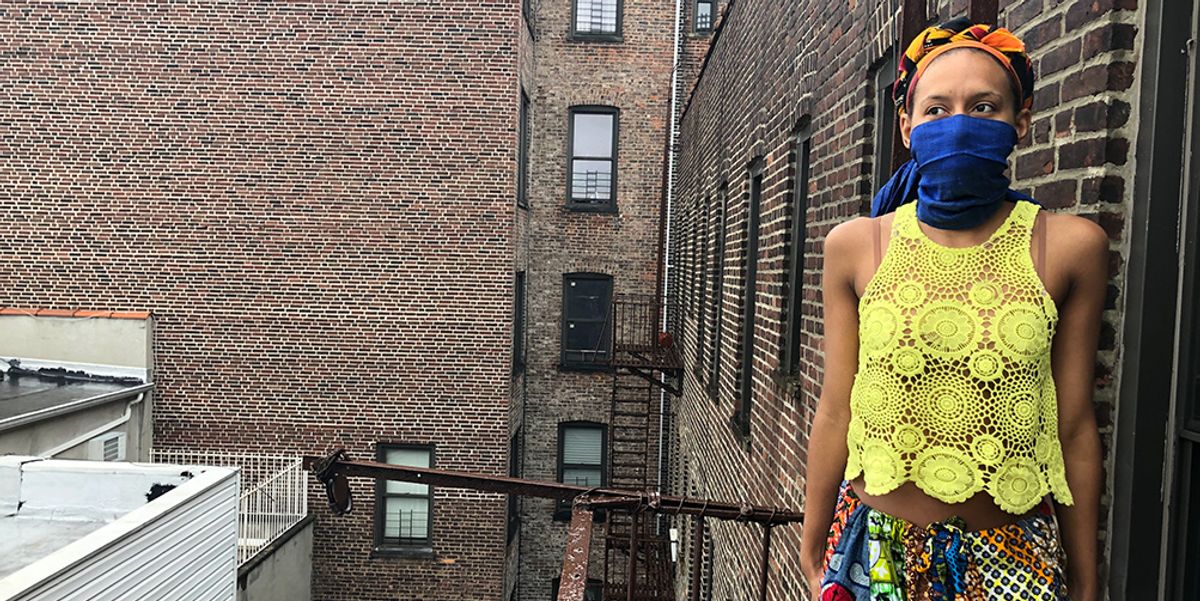6 of Our Favorite Digital Dance Projects to Come Out of Quarantine
Limitations foster creativity. While unable to gather in person due to COVID-19, dancers, choreographers and companies have taken to the internet to create new projects conceived for the digital sphere. Here are just a few of our favorites.
Redefining Bravery

Mei Yamanaka in her as sure as sure can be
Mei Yamanaka, Courtesy Ladenheim
Curated by Kate Ladenheim and Brendan Drake, 19 Acts of COVID-19 Bravery commissioned artists to create digital works in response to everyday actions that have become charged with risk. Art Bridgman and Myrna Packer, filmed from above, moved to embrace but only encountered the other’s spectral form. Candace Thompson-Zachery’s hands reached into empty air in entreaty and offering in André M. Zachery’s meditation on being unable to come into contact with elders for fear of passing along infection. Ladenheim’s own project, a digital mood board titled This Crisis Looks Good On You, drew uncomfortable attention to the performative nature of optimism and optimization on social media. 19 Acts was one of the first projects to respond directly to the pandemic—and it directly supported the artists involved.
Slaying on Social
Professional dancers flooded TikTok while cooped up at home. But even in the sea of dance content, the Black Men of Concert Dance’s take on the #DontRushChallenge (in which a friend group goes from loungewear to dressed up with the swipe of a makeup brush over the camera) made waves. Produced and edited by Complexions Contemporary Ballet’s Maxfield Haynes, the five-minute video featured 25 artists hailing from a starry array of companies—from American Ballet Theatre and The Royal Ballet to Alvin Ailey American Dance Theater and Paul Taylor Dance Company—tossing ballet slippers and other items from one apartment to the next, inciting virtuosic, silly, groovy dancing. It closed with a surprise appearance from trailblazer Desmond Richardson, and an exhortation to donate to company relief funds or directly to the dancers who participated.
Someone to Lean On
With a cast of 209 people filmed in 29 countries, the official music video for “Lay Your Head On Me,” a single from Major Lazer featuring Marcus Mumford, was ambitious. But the key to its appeal lay in its simplicity and apparent lack of artifice, and in the sense of connectedness it evoked. Individuals varying wildly in age and level of training were filmed performing Ryan Heffington’s choreography. From the genuine, uninhibited smiles on the dancers’ faces, dancing it brought them as much joy as we felt watching.
An Open Invitation

Bobby Rogers, Courtesy Walker Art Center
Faye Driscoll’s first solo museum exhibition, “Faye Driscoll: Come On In,” had been open for little more than two weeks when the Walker Art Center closed its doors. The exhibition invited visitors to sit or recline on padded platforms while listening to meditative prompts recorded by Driscoll, creating an ever-evolving living sculpture gallery. Driscoll and the Walker reimagined part of the exhibition as an online experience. Visitors were introduced to Driscoll’s work and shown images of the space before being invited to listen to one of the six audio tracks and follow along with the subtle directives at home—an experience that simultaneously transported you elsewhere and grounded you in your own skin.
Illusions I Recall
Presented by Dixon Place as part of its Virtual Exposure offerings, BREAKTIME’s This Meeting Is Being Recorded offered a sad, surrealistic meditation on the drabness of Zoom interactions. Holly Sass and Jonathan Matthews played with the video chat’s digital borders, shocking each other when their hands appeared to meet, Sass’ head becoming Matthews’ foot as it pressed from their side of the call to his. The two ultimately merged into two halves of one person as they frantically lip-synced Joni Mitchell’s “Both Sides, Now.”
Wilis at Home
The Australian Ballet’s “Wilis in Corps-en-tine” video was an inspired marketing move, a perfect ballet synopsis and a delightfully tongue-in-cheek satire of Zoom culture, complete with jokes about that one person who forgot to enable their video and heaps of meme references. Bored dancers in their sweatpants at home were reimagined as Wilis on a video call, dishing the gossip about what Albrecht and Hilarion put poor Giselle through. Myrtha, when she joined the call, encouraged the ladies to “get in formation,” and the corps leapt into costumes to do what Wilis do best—from their apartments.
Boxed In
Works & Process at the Guggenheim commissioned virtual works from dozens of artists. Cooped, in which Alvin Ailey American Dance Theater resident choreographer Jamar Roberts writhed, contorted and shook in claustrophobic spaces, was a response to the disproportionate impact of COVID-19 on people of color, and the ways quarantine echoed the historic confinement of Black people. In the week after its May 24 debut, the short film gained an aura of discomfiting prescience as renewed Black Lives Matter protests erupted following the murder of George Floyd.




